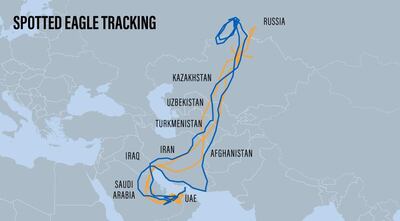A greater spotted eagle that has flown the equivalent of the earth’s circumference - twice - has returned to winter in Abu Dhabi.
Eagle #296 is not remarkable for her species. Greater spotted eagles migrate overland every autumn from southern Russia and northern Kazakhstan to Europe, North Africa, the Gulf and sometimes beyond, to north east Africa. By the first week of April, they leave again for central Asia for the spring breeding season on the steppes.
The species is found throughout the UAE but Eagle #296 is unique because she been tracked by the Environment Agency Abu Dhabi since 2015. The agency began monitoring greater spotted eagles with solar-powered trackers in 2005 but devices usually stop working after two or three years.
Eagle #296 gives a rare insight into the remarkable distances her species covers in its lifetime. In just three and a half migrations, she has racked up nearly 80,000 kilometres. That’s enough to circle the earth twice.
“Nobody knows how far they travel in a lifetime but you can imagine if they have clocked about 80,000 in just a few years,” said Dr Salim Javed, the agency's acting director of terrestrial biodiversity.
Understanding migratory routes and resting sites is critical to the survival of the species. There are fewer than 10,000 mature individuals left in the world and creating a network of protected areas is essential, said Dr Javed.
"The global community needs to focus more attention on assuring that its flyways and stopover sights are more protected," he said. "At the moment their population may be declining and vulnerable but these animals are resilient and they can always bounce back providing we provide the right resources on the ground. A lot of birds get killed for no rhyme and reason."

The eagles follow a single path over the Gulf states, through Saudi Arabia, Iraq and Iran but diverge once they hit the Caspian Sea, to the east and west, suggesting two distinct populations converge in the Gulf each winter.
The migration takes about three weeks. They can travel 500 to 600km a day, soaring across hostile terrain and resting for a day or two at a time. Identifying stopover points can allow countries to create safe and continuous migratory routes.
“Migratory birds connect one site to another, one country to another country,” said Dr Javed. “On the way to the UAE they stop in Iraq, Iran Turkmenistan, Kazakhstan and Russia, so they are one of the biggest ambassadors for conservation, they carry that message across borders.”
It is a solitary journey. They can travel with groups of five or six but are usually alone, and known for their puppy-like cry.
It is a perilous route, even for an apex predator. Some cross the Bab Al Mandab Strait into Africa and, in addition to nature’s dangers, there is the ever present threat of poaching.
Eagle #296 travels from Russia and Kazakhstan over Tajikistan, Turkmenistan, Iran, Iraq and Saudi Arabia. The overland route is thousands of kilometres longer than crossing the sea but is far safer and allows eagles a chance to rest, and feed on small mammals.
“Migratory birds are so fascinating, they just blow your mind sometimes,” said Dr Javed. “Despite all the hardship they still make it. Migration itself is very challenging because it takes a lot in terms of resources and then you have vulnerability on the ground so if they make it, it’s a big achievement. We are so happy when they finally get back to Abu Dhabi safely. It’s like your kid coming back home from school.”
In the Emirates, Greater Spotted Eagles are commonly seen along the coast and wetlands like Al Wathbah, Ras Al Khor, Khor Al Beida and into Ras Al Khaimah. Wetlands have small migratory birds the eagles feed upon and their widespread conservation is critical for eagles.
“Connectivity is very important,” said Dr Javed. “One wetland is not enough. It needs a network. If we just have wetlands in Abu Dhabi and not in Dubai or Ras Al Khaimah or Fujairah, it is not enough.”
The species is listed as vulnerable on the IUCN Red list.
Scientists at the agency are currently tracking six eagles.
Understanding the migration and sharing this information with others along the migratory group is fundamental to the species’ conservation, said Dr Javed.
“The challenge is habitat protection. In protecting any wild species we need to ensure the habitat is well protected and safe from predators and poachers.”

